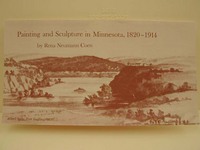As a researcher and museum fanatic, to read back on the events and accomplishments of the exhibit titled, “A Bicentennial Exhibition of Minnesota Art and Architecture,” I felt the need to push my jaw back up to meet my front bite, after the many drops in awe of the events surrounding this exhibition, the records for which filled ¾ of Box 16, the entirety of Box 17, and even a few more folders that lingered into Boxes 18 and 19.
The contents of each folder document an exhibit that was too large in scope and size to be held in the gallery space of Northrop Auditorium, contain planning notes and correspondence, and document partnerships that resulted in the exhibit’s installation and exhibition at the 8th floor auditorium of Dayton’s department store in downtown Minneapolis from February 11 to March 5, 1976.
The exhibit presented Minnesota painting and sculpture from 1820-1914 and architecture from 1820 to the then present day. Made possible by funding from the National Endowment for the Arts, and the support of foundations, corporations and individuals, this expansive, interdisciplinary exhibit was the result of the first statewide survey of MN art and architecture and also contributed to the publication of two works, “Painting and Sculpture in Minnesota, 1820-1914,” authored by Dr. Rena Coen, and “A Guide to the Architecture of Minnesota” by Dr. David Gebhard and Thomas Martinson. Through research and discovery, important MN artworks such as Alexis Jean Fournier’s scenes of Minneapolis and St. Paul, and Thomas Pritchard Rossiter’s depiction of the Minnesota prairie, received conservation work. Forty-four works, held amidst the collections of MN Historical Society to the Winona County Historical Society were restored at the cost of more than $10,000 (funded by a grant).
The exhibit included paintings and artworks with themes of explorers, soldiers, tourists and settlers. Also included were works of Indian ways of life, MN landscapes, and decorative objects created by Minnesota citizens.
Events surrounding the exhibit included Native American craft demonstrations (pipe carving, beadwork), a lecture series titled, “Exploring Minnesota” which covered regional culture in 19th century Minnesota, a lecture series, and panel discussions on the topic of “Encounters in Architecture” were held.
The touring exhibition, which reached 19 MN cities, was the starting point of the University Gallery’s long running touring exhibition program. Forty paintings out of the 200 exhibited in Dayton’s auditorium were selected to join the many cases of Native American art objects selected to tour the state – to bring art to the rural communities of Minnesota. From the first stop in the tour, Willmar, then a population of 13,632, to the last stop, St. Cloud (42,223), with many other stops in-between, the Bicentennial Exhibition made it’s mark by bringing state-treasured artwork to the citizens of greater Minnesota.
And if you thought that the extent of this exhibit could go no further, one final element of the touring exhibition must be revealed. Transportation for the exhibit was organized by the Minnesota Motor Transport Association. Student truck-drivers from the Vocational-Technical Institute #916 Truck Driver Training program received practical driving experience as they carried treasured artwork, in an insulated temperature and humidity controlled trailer, to communities across the state.
Listen to current Weisman Art Museum Director Lyndel King, who directed the Bicentennial Exhibition as acting director of the University Art Gallery in 1976, describe the accomplishments of this exhibition:
Bicentennial Description_King.mp3
Learn more about the exhibit: An article titled, “‘Little Gallery’ accomplishes a big job,” which includes photographs and examples of featured artwork and architecture, was published in the University of Minnesota Alumni News, April 1977. Vo. 76 No. 8. Access a PDF of the Alumni News from the U of M’s Digital Conservancy. The article is on page 20 of the magazine.

